Canary Wharf
| Canary Wharf | |
|---|---|
 Skyline of Canary Wharf, viewed from the west at night. | |
 Canary Wharf | |
| Canary Wharf shown within Greater London | |
| Population | 73,390 (Millwall, Blackwall and Cubitt Town, East India and Lansbury and Limehouse wards 2011 Census) |
| OS grid reference | TQ375802 |
| London borough | |
| Ceremonial county | Greater London |
| Region | |
| Country | England |
| Sovereign state | United Kingdom |
| Post town | LONDON |
| Postcode district | E14 |
| Dialling code | 020 |
| Police | Metropolitan |
| Fire | London |
| Ambulance | London |
| EU Parliament | London |
| UK Parliament | |
| London Assembly | |
Canary Wharf is a major business district in east London, within the London Borough of Tower Hamlets. It is one of the United Kingdom's two main financial centres – along with the traditional City of London – and contains many of Europe's tallest buildings, including the second-tallest in the UK, One Canada Square.[1][2]
Canary Wharf contains around 16,000,000 square feet (1,500,000 m2) of office and retail space, of which around 7,900,000 square feet (730,000 m2) (about 49%) is owned by Canary Wharf Group.[3] Around 105,000 people work in Canary Wharf,[4] and it is home to the world or European headquarters of numerous major banks, professional services firms, and media organisations, including Barclays, Citigroup, Clifford Chance, Credit Suisse, EY, Fitch Ratings, HSBC, Infosys, J.P. Morgan, KPMG, MetLife, Moody's, Morgan Stanley, RBC, S&P Global, Skadden, State Street, and Thomson Reuters.[5]
History



Canary Wharf is located on the West India Docks on the Isle of Dogs.
From 1802 to 1939, the area was one of the busiest docks in the world. After the 1960s, the port industry began to decline, leading to all the docks being closed by 1980.[6][7] Of the three main docks of the West India Docks, the Canary Wharf estate occupies part of the north side and the entire south side of the Import Dock (North Dock), both sides of the Export Dock (Middle Dock) and the north side of the South Dock.
Canary Wharf itself takes its name from No. 32 berth of the West Wood Quay of the Import Dock. This was built in 1936 for Fruit Lines Ltd, a subsidiary of Fred Olsen Lines for the Mediterranean and Canary Islands fruit trade. The Canary islands were so named after the large dogs found there by the Spanish (Gran Canaria from Canine) and as it is located on the Isle of Dogs, the quay and warehouse were given the name Canary Wharf.[8]
After the docks closed in 1980, the British Government adopted policies to stimulate redevelopment of the area, including the creation of the London Docklands Development Corporation in 1981 and the granting of Urban Enterprise Zone status to the Isle of Dogs in 1982.[7]
The Canary Wharf of today began when Michael von Clemm, former chairman of Credit Suisse First Boston (CSFB), came up with the idea to convert Canary Wharf into a back office. Further discussions with G Ware Travelstead led to proposals for a new business district.
The project was sold to the Canadian company Olympia & York[9] and construction began in 1988, master-planned by Skidmore, Owings & Merrill with Yorke Rosenberg Mardall as their UK advisors, and subsequently by Koetter Kim. The first buildings were completed in 1991, including One Canada Square, which became the UK's tallest building at the time and a symbol of the regeneration of Docklands. By the time it opened, the London commercial property market had collapsed, and Olympia and York Canary Wharf Limited filed for bankruptcy in May 1992.
Initially, the City of London saw Canary Wharf as an existential threat. It modified its planning laws to expand the provision of new offices in the City of London, for example, creating offices above railway stations (Blackfriars) and roads (Alban Gate). The resulting oversupply of office space contributed to the failure of the No 1 Canada Square project.
In 1997, some residents living on the Isle of Dogs launched a lawsuit against Canary Wharf Ltd for private nuisance because the tower interfered with television signals. The residents lost the case.[10]
In December 1995 an international consortium, backed by the former owners of Olympia & York and other investors, bought the scheme. The new company was called Canary Wharf Limited, and later became Canary Wharf Group.
Recovery in the property market generally, coupled with continuing demand for large floorplate Grade A office space, slowly improved the level of interest. A critical event in the recovery was the much-delayed start of work on the Jubilee Line Extension, which the government wanted ready for the Millennium celebrations.
In March 2004, Canary Wharf Group plc. was taken over by a consortium of investors, backed by its largest shareholder Glick Family Investments[11] and led by Morgan Stanley using a vehicle named Songbird Estates plc.
At the peak of property prices in 2007, the HSBC building sold for a record £1.1 billion.[12]
In March 2014 planning permission was granted for the second residential building on the Canary Wharf estate, a 58-storey tower including 566 apartments plus shops and a health club.[13]
In July 2014 Canary Wharf Group was granted planning permission for a major eastwards expansion of the Canary Wharf estate.[14][15] The plans include the construction of 30 buildings comprising a total of 4.9 million square feet, including shops, 1.9 million square feet of commercial offices and 3,100 homes.[14][15] Construction is planned to commence in autumn 2014 with the first buildings to be occupied at the end of 2018.[14]
In 2014, Singapore listed Oxley Holdings, together with developer Ballymore UK, have a joint venture to set up a new waterfront township of Royal Wharf with 3385 new homes housing over 10,000 people.
Tallest buildings
This table lists completed buildings in Canary Wharf that are over 60 metres tall.
| Ranking by height | Image | Name | Height | Floors | Completion date | Notes | |
|---|---|---|---|---|---|---|---|
| Metres | Feet | ||||||
| 1 | 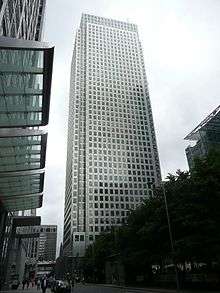 | One Canada Square | 235 | 771 | 50 | 1991 | The second-tallest completed building in the United Kingdom, the tallest being The Shard. Designed by Cesar Pelli, it was the tallest building in Europe upon completion in 1991. Multi-tenanted; occupiers include The Bank of New York Mellon, the CFA Institute, Clearstream, EEX (European Energy Exchange), Euler Hermes, the International Sugar Organization, Mahindra Satyam, MetLife, Moody's Analytics and Trinity Mirror.[16] |
| 2 |  | 8 Canada Square | 200 | 655 | 42 | 2002 | The joint fifth-tallest completed building in the United Kingdom. Occupied by HSBC as its world headquarters.[17] |
| 3 |  | 25 Canada Square | 200 | 655 | 42 | 2001 | The joint fifth-tallest completed building in the United Kingdom. 25 Canada Square and 33 Canada Square together form a single complex known as the Citigroup Centre. Primarily occupied by Citigroup as its EMEA headquarters.[18] Other tenants include Gain Capital, 3i Infotech, Lehman Brothers (in Administration), Crossrail, Instinet, Munich Re, MWB Group, SunGard, Interoute and Wells Fargo. |
| 4 |  | One Churchill Place | 156 | 513 | 32 | 2005 | Occupied by Barclays as its world headquarters.[19] Currently the eighth-tallest building in the United Kingdom, it was originally planned to be 50 stories in height, but was scaled down to 31 after the 11 September attacks. |
| 5 |  | 40 Bank Street | 153 | 502 | 33 | 2003 | Multi-tenanted; occupiers include Allen & Overy, ANZ Bank, China Construction Bank, Duff & Phelps, Saxo Bank and Skadden, Arps, Slate, Meagher & Flom.[16] |
| 6 | 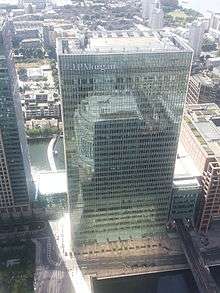 | 25 Bank Street | 153 | 502 | 33 | 2003 | Occupied by JP Morgan Chase as its European headquarters since 2012.[20] |
| 7 |  | 10 Upper Bank Street | 151 | 495 | 32 | 2003 | Occupied by Clifford Chance as its world headquarters.[21] Other occupiers include FTSE Group, Infosys, MasterCard, Deutsche Bank and Total.[16] |
| 8 |  | 25 Churchill Place | 130 | 426 | 23 | 2014 | The building houses the European Medicines Agency from early 2014 and Ernst & Young from 2015. |
| 9 | 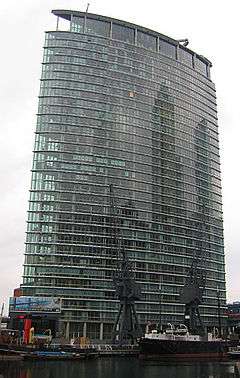 | 1 West India Quay | 108 | 354 | 36 | 2004 | Floors 1-12 are occupied by a Marriott Hotel.[22] Floors 13-33 house 158 apartments. |
| 10 |  | 33 Canada Square | 105 | 344 | 18 | 1999 | 33 Canada Square and 25 Canada Square together form a single complex, see above for details. |
| 11 | 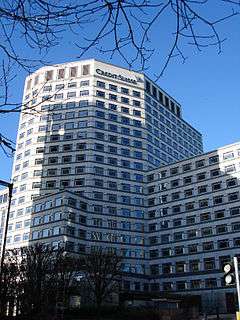 | 1 Cabot Square | 89 | 292 | 21 | 1991 | Occupied by Credit Suisse.[23] |
| 12 | 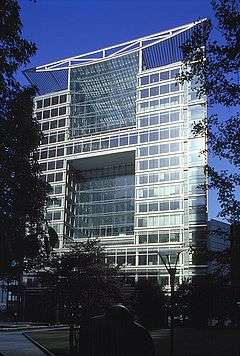 | 5 Canada Square | 88 | 288 | 16 | 2003 | Occupied by Bank of America Merrill Lynch.[16] |
| 13 |  | 25 Cabot Square | 81 | 265 | 17 | 1991 | Occupied by Morgan Stanley. Morgan Stanley also occupies the nearby 20 Bank Street as its European headquarters.[24] The architect was Skidmore, Owings & Merrill. |
| 14 | 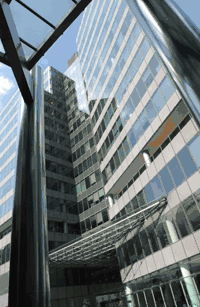 | 25 North Colonnade | 80 | 262 | 15 | 1991 | Occupied by the Financial Conduct Authority as its headquarters.[16] The architect was John McAslan and Partners. |
| 15 | 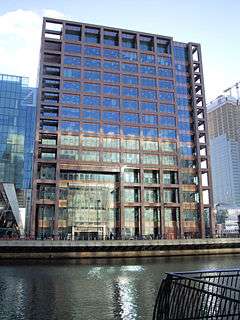 | 20 Bank Street | 68 | 223 | 14 | 2003 | Occupied by Morgan Stanley as its European headquarters. Morgan Stanley also occupies the nearby 25 Cabot Square. It was designed by Skidmore, Owings & Merrill. |
Transport
The Canary Wharf developers played a pro-active role in improving transport links, which they recognised as essential to the success of the project.
Beginning in 1985, they proposed extension of the Docklands Light Railway (DLR) to Bank, and upgrading of frequencies and capacity. The DLR now serves three stations in the area: West India Quay, Canary Wharf, Heron Quays.
In 1988, they proposed construction of a second rail line to Docklands, which ultimately became the Jubilee Line Extension. After the Jubilee Extension opened in 1999, Canary Wharf began to actively promote Crossrail, as a new station on Crossrail's Elizabeth line will serve the area. It's due to be open in December 2018.
- Aviation

London City Airport in Silvertown is linked to both Canary Wharf and the City of London via the Docklands Light Railway, and an interchange to the London Underground. London City Airport DLR station is situated immediately adjacent to the terminal building, with enclosed access to and from the elevated platforms. The Vanguard helipad serves a parcel service by helicopter to Heathrow Airport.[25]
- London Buses
Canary Wharf is served by several London Buses routes, including route 135 connecting the estate with Old Street for East London Tech City and Crossharbour and the 24 hours route 277 to Highbury via Bow, Hackney Central, Dalston from Crosshabour via Millwall and also the D prefix network serving the London Docklands with the D3 running between Bethnal Green and Leamouth via Wapping and D7 between Mile End and Poplar while the D8 from Crossharbour to Stratford via Bromley-by-Bow and the night route N550 between Trafalgar Square and Canning Town and has been since its beginning, which has been vital in the continuing development of the estate.
- Docklands Light Railway
Heron Quays Station, one of the first stations to be built in the Canary Wharf estate, was first opened in 1987. The station has two platforms in use, is in Travelcard Zone 2, and is on the Lewisham branch of the Docklands Light Railway, between Canary Wharf and South Quay. The station was moved 200 metres south (to fit inside the new buildings) and a longer platform was built at this new site to accommodate three-unit trains planned as part of the DLR Capacity Enhancement; the station re-opened on 18 December 2002.
Canary Wharf Station had been part of the original DLR plans, but the station was not ready when the DLR opened in August 1987. It was originally planned that the station would be similar to the original station at Heron Quays, with two small platforms either side of the tracks. The station is located on the DLR between Heron Quays station and the West India Quay station, in Travelcard Zone 2.
- London Underground
The Canary Wharf tube station is a two platform station designed by Norman Foster and opened in 1999 as part of the Jubilee Line Extension from Charing Cross to Stratford. Canary Wharf station has increasingly become one of the busiest stations on the network, serving the ever-expanding Canary Wharf business district.
The station was used as a location for some scenes of Danny Boyle's 2002 film 28 Days Later and its sequel 28 Weeks Later, which was mostly based in Canary Wharf.
- National Rail
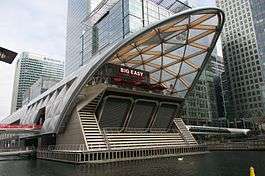
Canary Wharf railway station began construction in May 2009 and will be completed in 2017 (due to officially begin operating in 2018) as part of the £17 billion Crossrail project. The station will be served by the Elisabeth line and will have two platforms and will be in Travelcard Zone 2.
- London River Services
The Canary Wharf Pier is a London River Services pier on the River Thames located to the west of Canary Wharf, close to Narrow Street, Limehouse.
- Cycling
Cycle Superhighway CS3 between Tower Gateway and Barking passes to the north of Canary Wharf near Westferry station and the National Cycle Route passes to the west on the Thames Path.
See also
References
- ↑ "Heron Tower becomes tallest building in The City". BBC News. 21 February 2010. Retrieved 11 November 2010.
- ↑ "United Kingdom list of tallest buildings". SkyscraperPage.com. Retrieved 12 January 2009.
- ↑ "Higher occupancy lifts Canary Wharf's Songbird". Reuters. 22 March 2007. Retrieved 11 November 2010.
- ↑ "Canary Wharf boss sees future in creative campus - Financial News". Retrieved 3 March 2014.
- ↑ "China to invest in Canary Wharf". China Economic Review. 31 August 2009. Retrieved 11 November 2010.
- ↑ West India Docks (1803-1980) (Port Cities) accessed 22 July 2008
- 1 2 "History". Canary Wharf Group. Retrieved 11 November 2010.
- ↑ The West India Docks: The buildings: warehouses, Survey of London: volumes 43 and 44: Poplar, Blackwall and Isle of Dogs (1994), pp. 284-300. Retrieved 22 July 2008
- ↑ "The Development of Transport in London Docklands - Part I: The Chronological Story". LDDC history. 17 July 1987. A New Era: the Coming of Canary Wharf. Retrieved 12 January 2009.
- ↑ The court found against the appellants (Hunter and others) as private nuisance legislation generally concerns "emanations" from land, not interference with such emanations. "Hunter and Others v. Canary Wharf Ltd./Hunter and Others v. London Docklands Corporation" House of Lords Session 1996-97. Retrieved on 23 March 2009.
- ↑ "Glick family in late move over Canary Wharf battle - Business News, Business - The Independent". 2 January 2011. Archived from the original on 2 January 2011.
- ↑ Saunders, Craig (19 June 2007). "Canary Wharf singing a red-hot tune". The Globe and Mail. Retrieved 12 January 2009.
- ↑ "Canary Wharf to get first residential building". The Telegraph. 16 March 2014. Retrieved 27 July 2014.
- 1 2 3 "Canary Wharf spreads east with new towers and 3,000 homes planned". The Guardian. 22 July 2014. Retrieved 27 July 2014.
- 1 2 "Canary Wharf extension to entice tech companies away from Silicon roundabout". The Telegraph. 22 July 2014. Retrieved 27 July 2014.
- 1 2 3 4 5 "Who's Here". Canary Wharf Group plc. Retrieved 13 November 2010.
- ↑ "Contact us". HSBC Holdings plc. Retrieved 13 November 2010.
- ↑ "£16bn cross-London project to take four floors in Canary Wharf tower". Property Week. 6 June 2008. Retrieved 13 November 2010.
- ↑ "Corporate enquiries". Barclays Bank PLC. Retrieved 13 November 2010.
- ↑ Canary Wharf Group plc - Estate Map. Canarywharf.com (13 May 2010). Retrieved on 2013-07-12.
- ↑ "United Kingdom". Clifford Chance. Retrieved 13 November 2010.
- ↑ "Contact Us". Marriott International, Inc. Retrieved 8 March 2011.
- ↑ "Contact Us". Credit Suisse. Retrieved 13 November 2010.
- ↑ "Morgan Stanley in the United Kingdom". Morgan Stanley. Retrieved 13 November 2010.
- ↑ Weiss, Richard. "DHL Speeds Deliveries With Heathrow-Canary Wharf Helicopter Run" Bloomberg, 21 January 2015. Archive
Further reading
- Kevin D'Arcy (2012). London's 2nd City: Creating Canary Wharf. Rajah Books. ISBN 0955670624.
External links
| Wikimedia Commons has media related to Canary Wharf. |
- Canary Wharf – Official Information Site
- Canary Wharf Group plc
- Canary Wharf projects on Skyscrapernews
- The Definitive Guide to Canary Wharf Pier

